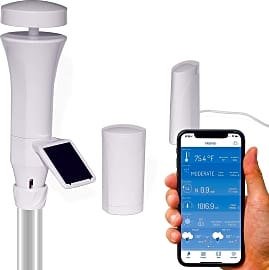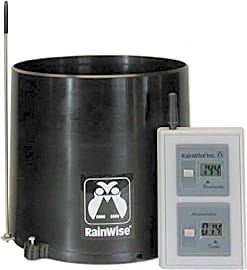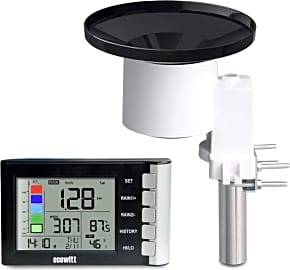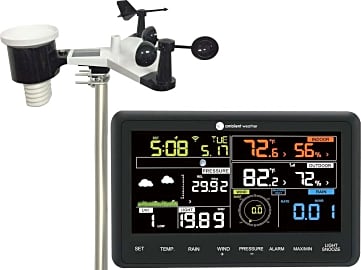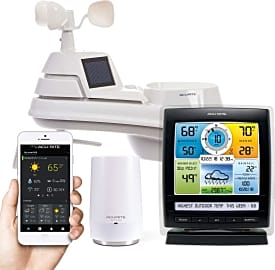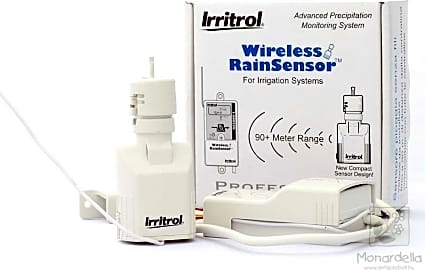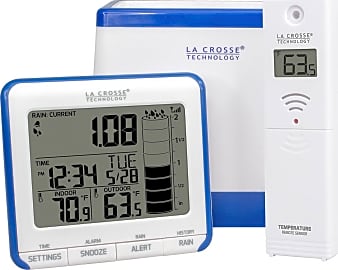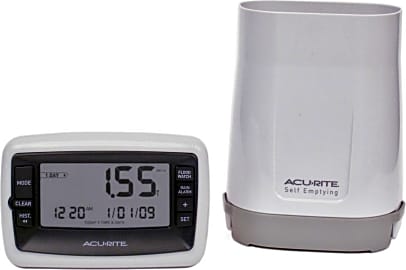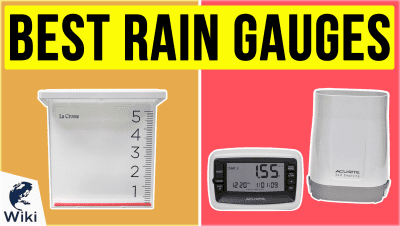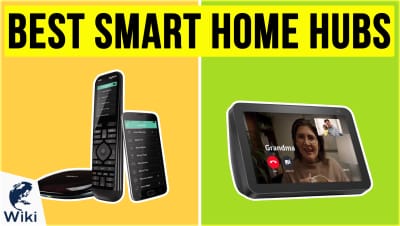The 10 Best Wireless Rain Gauges

This wiki has been updated 34 times since it was first published in February of 2017. Whether you’re interested in meteorology, carefully controlling how much water you use on your lawn or fields, or trying to monitor how full your cistern is, these wireless gauges can accurately check and report on the amount of rain that has fallen. Our list includes a wide variety of options, ranging from simple models to deluxe, Wi-Fi-connected personal weather stations. When users buy our independently chosen editorial choices, we may earn commissions to help fund the Wiki.
Editor's Notes
November 20, 2020:
We rounded out the list today with the RainWise Rainew, a low-maintenance model with an LCD console that displays both current and cumulative precipitation amounts. It reports down to the hundredth of an inch, making it useful for the serious gardener or anyone who runs a nursery. The counter features a button that allows you to reset it to zero after each rainfall. A keyhole slot on the back provides for convenient wall mounting. The self-emptying rain collector has a diameter of eight inches, and every time it tips a count is transmitted to the console inside. You never have to manually empty the gauge. The Ecowitt WH5360B also comes on board, and its comprehensive display shows data like current and historic rainfall totals. You can set it up to provide customized alerts regarding things like rain rate, indoor temperature, and humidity.
We moved the Davis Instruments Vantage Vue into a more prominent spot on the list, as it has a lot to offer as far as durability, data provided, and ease of use. The indoor console is a cinch to operate in the dark, thanks to a backlit display and glow-in-the-dark keypad. It shows information such as wind speed and direction, dew point, barometric pressure, indoor and outdoor temperature, and rainfall. It also shows the current moon phase and weather forecast icons. It’s solar-powered with a handy battery backup. We also moved the WeatherFlow Smart Home closer to the top spot. Like the Vantage Vue, the outdoor component is powered by the sun’s energy, and it reports on barometric pressure, wind speed and direction, UV index, dew point, and much more. It can be paired with a smart home hub to do things like turn on fans if the indoor temperature is high or adjust your watering schedule based on rain that’s fallen. It also works with voice-controlled assistants like Amazon Alexa and Google Home.
October 21, 2019:
A wireless rain gauge is convenient when you want to monitor precipitation amounts in your yard, garden, or field, and many models are personal weather stations that offer much more data, like barometric pressure, humidity, wind speeds, etc. Although non-Wi-Fi rain gauges are often durable and accurate, nothing beats being able to read the measurements from the comfort of your warm, dry house – day or night.
Joining our selection today is the Davis Instruments Vantage Vue, which features a console that’s easy to read and use, thanks to its large, backlit LCD and glow-in-the dark keypad. You’ll always be in-the-know with information that’s updated every 2.5 seconds regarding indoor and outdoor temperatures, humidity, barometric pressure, wind speed and direction, dew point, rainfall, and the moon’s current phase. The solar-powered sensor has a lithium battery backup, and it comes with all required the mounting hardware.
The AcuRite 01012M is another new addition that’s packed with useful features and information. You can monitor outside conditions on a mobile device or a computer, and it can transmit data to as many as seven devices at a time. If you want to be alerted to rain or other weather events, you can set it up to send customized notifications to your smartphone. A ticker stream on the console also sends useful, real-time information. This one is also compatible with Amazon Alexa. (Just say, “Alexa, ask my AcuRite about my backyard weather.”)
The third addition today is the WeatherFlow Smart Home, a reliable choice that features two outdoor sensors: “Sky,” which is to be placed in full sunlight and collects data on the UV index, rainfall, and wind speed, and direction; and “Air,” which is to be placed in the shade and measures temperature, humidity, and atmospheric pressure. It can also detect nearby lightning and approaching storms. The Wi-Fi hub component connects directly to your home network and publishes your data online, so you can access it from a compatible mobile device.
Leaving the list in this update are the General Tools 3-In-1 and the RainWise Dual Display, which are no longer available at this time, as well as the Oregon Scientific Remote, amidst reports the screen experiences problems with blinking and that it can have a relatively short working life.
Special Honors
Sharper Image Digital Wireless Rain Gauge This device makes for the perfect gift for any amateur meteorologist, as it offers a large, backlit screen that displays a wealth of weather information from the comfort and safety of your warm, dry home. Just place the two sensors outside as directed, and you’ll have access to a 24-hour rain alert, rainfall display in inches or millimeters, a temperature and humidity sensor, and a total rain history view from the past hour, day, 7 days, month, or year. A handy cylinder graph displays 10 sections of current conditions. Data can be displayed in English, French, or Spanish, and it features a low-battery indicator. It can be run on two AA batteries or charged via USB. sharperimage.com
Precision Of Precipitation
By contrast, the wireless unit automatically takes precipitation readings at regular intervals and with greater precision, thanks to its internal components.
When I was a kid, I remember thinking of inventive ways to keep myself busy. As an example, I can recall stacking a bunch of my mom's makeup mirrors on top of one another on my windowsill on a rainy day, assuming their reflection of available light would bounce back on the clouds causing a downpour. I have no idea where the logic of that pseudoscience came from, and I eventually came to realize that a mirror was incapable of seeding a cloud. Little did I know that childlike wonder, curiosity, and desire to learn about rain and its measurements could have been partially satisfied with a simple bucket to catch the water. Today, there are more accurate tools specifically-dedicated to providing rainfall measurements for a variety of purposes. One such tool is the wireless rain gauge.
Regardless of its type, a rain gauge is defined as a meteorological instrument designed to measure the amount of precipitation that falls within a specific time interval in a certain location. The tool typically leverages a cylindrical cup and funnel system. In this type of setup, a rain gauge's funnel channels water into a cylinder, which is inside an even larger container that fills up and ultimately collects any and all water. When measurements are taken, the volume of water in both the cylinder and container deliver an exact reading for the total amount of precipitation that actually fell in a given time period. Many wireless rain gauges utilize a tipping bucket operation. In this scenario, two small buckets are mounted to a fulcrum and balanced like a see-saw. The buckets are tightly-manufactured and designed to hold an exact amount of precipitation (around 0.01 inch or 0.25 millimeters each). As one of the buckets fills with water, its weight eventually tips the levering mechanism down, allowing the bucket to empty itself. When this occurs, an electrical impulse is triggered by the gauge's internal electronic circuitry and transmitted by radio signal to a receiving/display unit, while the bucket on the opposite side of the lever pivots into place to take the next reading.
The measurements deliver a deeper understanding of a particular region’s weather conditions and, more importantly, the gauge offers important data about the local environment as a whole. Rain gauges are extremely beneficial for the purposes of local drought monitoring, they help homeowners and horticulturists improve the health and sustainability of their gardens, they assist farmers in assessing their ability to grow certain kinds of crops, and they provide researchers with a method for studying both current and past weather patterns in order to determine environmental trends.
Accuracy is a major benefit to the wireless rain gauge. Manual measurements not only leave room for error, but they're also more time consuming to take. By contrast, the wireless unit automatically takes precipitation readings at regular intervals and with greater precision, thanks to its internal components. Wireless data transmission (triggered by a self-emptying water bucket) essentially eliminates the need to wait until the rain stops in order to get measurements in the first place. Instead, real-time rainfall data may be obtained from the comfort of your own couch. Finally, wireless rain gauges are generally low-maintenance devices, only requiring occasional battery changes and checks for jams.
Recording Rainfall Without Fanfare
Accuracy is an important consideration to make when investing in a good wireless rain gauge, especially when detailed rainfall data is important to your livelihood as a farmer, researcher, meteorologist, or simply as a consumer in need of greater insight into your local precipitation patterns.
One capable of self-emptying its collected water will also help to improve accuracy.
Definitely go for a rain gauge with the ability to both store and display statistics over extended periods of time. One capable of self-emptying its collected water will also help to improve accuracy. Many of the options on our list function as all-in-one weather stations paired with easy-to-read LCD consoles that show you the date, time, and even the external temperature among other metrics. These consoles often come with their own built-in stands for tabletop use indoors or they can be mounted on the wall if your interior space is limited.
If you live in areas prone to flooding and other extreme weather events, consider an option with built-in flood warnings or rainfall alarms. While the flood warning is self-explanatory, the rainfall alarm is not as redundant as you might think. For example, if you utilize a simple irrigation system to water your plants, and the gauge's internal sensors detect a certain amount of rainfall in a given time period, the device can be programmed to alert you once its collection data has reached a predetermined threshold, allowing you to turn off your own water sources and save money in the long run.
A Brief History Of Wireless Rain Gauges
Rain gauges have a relatively rich history, with the earliest known records of rainfall data instituted by the ancient Greeks as early as 500 B.C.E. Ancient Indian, Middle Eastern, and Asian cultures also employed rain gauges to aid in determining ideal planting schedules.
The amount of recorded rainfall in various Chinese cities, for example, was used to estimate the total for the entire country.
Beginning around 1200 C.E., the use and popularity of rudimentary rain gauges spread throughout the Asian continent. The amount of recorded rainfall in various Chinese cities, for example, was used to estimate the total for the entire country.
English mathematician and physicist Sir Christopher Wren, in collaboration with naturalist philosopher Robert Hooke, developed one of the first tipping-bucket rain gauges in 1662. Similar in design to modern rain gauges, Hooke and Wren's device had a funnel-shaped top that channeled water into a collection basin. Subsequently, English mathematician Richard Towneley was the first to take extended rainfall measurements over a period of 15 years.
Today's digital rain gauges are fundamentally based on the working principles of Wren and Hooke's tipping-bucket design with the addition of LCD screens and wireless data transmission that can reach a distance of up to 300 feet, making them convenient, useful, and safe tools for a variety of precipitation studies.


